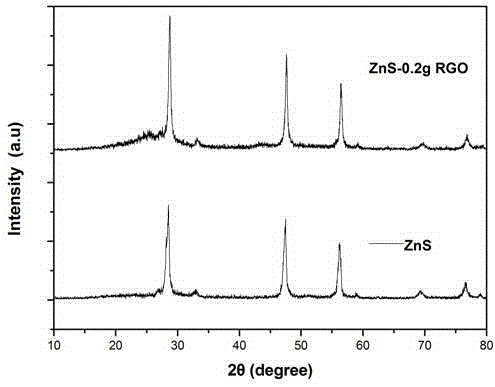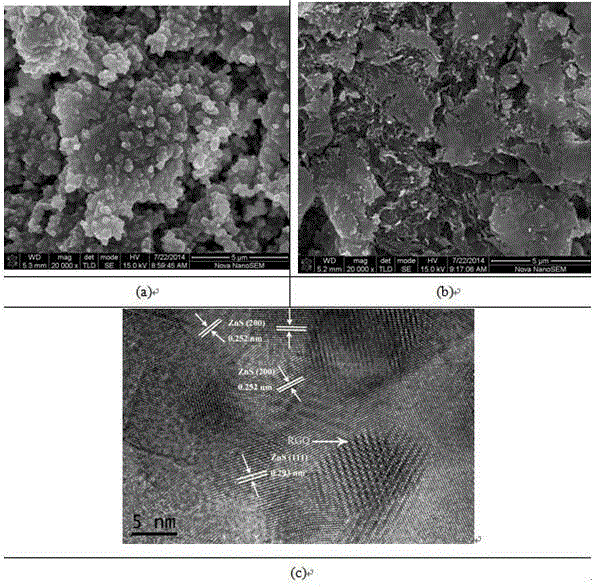Preparing method for zinc sulfide-graphene composite material for lithium ion battery negative electrode and application
A lithium-ion battery and graphene composite technology, applied in battery electrodes, batteries, negative electrodes, etc., can solve problems such as battery capacity and cycle stability effects
- Summary
- Abstract
- Description
- Claims
- Application Information
AI Technical Summary
Problems solved by technology
Method used
Image
Examples
Embodiment 1
[0050] (1) Preparation of graphite oxide (GO)
[0051] 1) Put a 250ml three-neck flask in an ice-water bath, add 80ml of concentrated sulfuric acid, 2g of graphite, and 1g of sodium nitrate in sequence, and stir for 1 hour; while keeping the temperature below 10°C, slowly add 3g of potassium permanganate into the flask , stir for 1 hour, remove the water bath;
[0052] 2) Under the condition of keeping the temperature below 20°C, slowly add 6g of potassium permanganate to the flask, heat to 35°C after the addition, keep stirring for 60 minutes; slowly add 90ml of distilled water to the flask, and heat up to 80°C, Insulate and stir for 30 minutes; add 7ml of 30% hydrogen peroxide and 55ml of distilled water to the solution, and let stand for 12 hours;
[0053] 3) Rinse the product with 3% dilute hydrochloric acid and distilled water, centrifuge 3 times, transfer to a 40°C oven for drying for 30 minutes, take it out, place it in a petri dish, and dry it at room temperature;
...
Embodiment 2
[0059] (1) Preparation of graphite oxide (GO)
[0060] 1) Put a 250ml three-neck flask in an ice-water bath, add 80ml of concentrated sulfuric acid, 2g of graphite, and 1g of sodium nitrate in sequence, and stir for 1 hour; while keeping the temperature below 10°C, slowly add 3g of potassium permanganate into the flask , stir for 1 hour, remove the water bath;
[0061] 2) Under the condition of keeping the temperature below 20°C, slowly add 6g of potassium permanganate to the flask, heat to 35°C after the addition, keep stirring for 60 minutes; slowly add 90ml of distilled water to the flask, and heat up to 80°C, Insulate and stir for 30 minutes; add 7ml of 30% hydrogen peroxide and 55ml of distilled water to the solution, and let stand for 12 hours;
[0062] 3) Rinse the product with 3% dilute hydrochloric acid and distilled water, centrifuge 3 times, transfer to a 40°C oven for drying for 30 minutes, take it out, place it in a petri dish, and dry it at room temperature;
...
Embodiment 3
[0068] (1) Preparation of graphite oxide (GO)
[0069] 1) Put a 250ml three-neck flask in an ice-water bath, add 80ml of concentrated sulfuric acid, 2g of graphite, and 1g of sodium nitrate in sequence, and stir for 1 hour; while keeping the temperature below 10°C, slowly add 3g of potassium permanganate into the flask , stir for 1 hour, remove the water bath;
[0070] 2) Under the condition of keeping the temperature below 20°C, slowly add 6g of potassium permanganate to the flask, heat to 35°C after the addition, keep stirring for 60 minutes; slowly add 90ml of distilled water to the flask, heat up to 80°C, Insulate and stir for 30 minutes; add 7ml of 30% hydrogen peroxide and 55ml of distilled water to the solution, and let stand for 12 hours;
[0071] 3) Rinse the product with 3% dilute hydrochloric acid and distilled water, centrifuge 3 times, transfer to a 40°C oven for drying for 30 minutes, take it out, place it in a petri dish, and dry it at room temperature;
[007...
PUM
 Login to View More
Login to View More Abstract
Description
Claims
Application Information
 Login to View More
Login to View More - R&D
- Intellectual Property
- Life Sciences
- Materials
- Tech Scout
- Unparalleled Data Quality
- Higher Quality Content
- 60% Fewer Hallucinations
Browse by: Latest US Patents, China's latest patents, Technical Efficacy Thesaurus, Application Domain, Technology Topic, Popular Technical Reports.
© 2025 PatSnap. All rights reserved.Legal|Privacy policy|Modern Slavery Act Transparency Statement|Sitemap|About US| Contact US: help@patsnap.com



